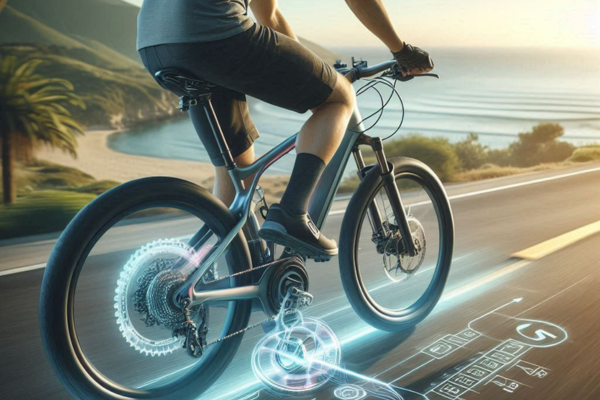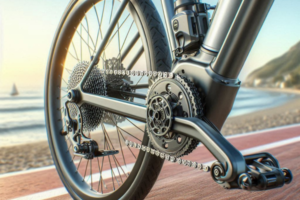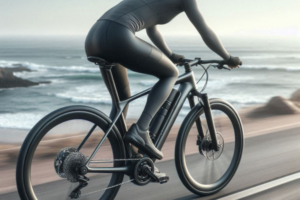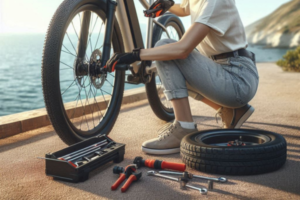⚙️ When to Shift Gears on an Electric Bicycle for Maximum Speed
Achieving maximum speed on an electric bicycle isn’t just about pedal-assist levels or motor wattage—it’s also about knowing when to shift gears. Mastering gear transitions helps you optimize motor performance, conserve battery power, and enjoy smoother, more efficient rides across different terrains and weather conditions. Whether you’re cruising along coastal roads or navigating urban traffic, learning how and when to shift gears will make a noticeable difference.
🔍 What Makes Shifting So Important on E-Bikes?
Unlike traditional bikes, e-bikes combine human power with electric motor assistance. This dual input requires harmony between your pedaling cadence and the bike’s gear ratio. If you’re in the wrong gear, your motor has to work harder, draining your battery faster and potentially causing strain on the drivetrain. On the other hand, the right gear at the right time allows both your body and your motor to perform more efficiently, resulting in higher speeds and a more enjoyable ride.
⚡ Gearing Basics for Electric Bicycles
Understanding the basics of gear usage can significantly boost your control and confidence. Here’s a quick breakdown:
- Low gears: Best for uphill climbs, headwinds, or starting from a stop. They offer more torque and make pedaling easier.
- Mid gears: Ideal for flat terrain and maintaining a moderate speed with comfortable cadence.
- High gears: Used when riding at higher speeds on flat or downhill roads. These gears reduce cadence but maintain momentum.
What sets e-bikes apart is that motor assistance multiplies your effort—but only if the drivetrain is working efficiently. That’s why knowing when to shift becomes key to maximizing the speed you can achieve without unnecessarily draining your battery or overloading your motor.
💡 Pro Insight: Think of shifting like breathing for your e-bike. If you time it right, everything flows better—from speed to energy to comfort.
🚴♀️ Strategic Shifting: How Terrain and Cadence Impact Speed
Knowing when to shift gears isn’t just about feeling fast—it’s about understanding how terrain, cadence, and resistance work together. Smart shifting ensures that you’re always in the most efficient gear for the road ahead, allowing both your legs and your e-bike’s motor to perform optimally. Whether you’re on a steep hill, a breezy coastal path, or a city boulevard, shifting gears at the right time can dramatically affect your acceleration, speed, and comfort.
🏔️ Uphill Riding: Time to Downshift
When facing an incline, your first instinct might be to rely on the motor’s power alone—but downshifting to a lower gear before the hill begins is smarter. Lower gears increase torque, making it easier to maintain a steady cadence. This reduces the strain on the motor, prevents overheating, and extends battery range.
- Shift before the climb starts to avoid grinding or losing momentum.
- Use lower pedal-assist levels in combination with low gears for natural, efficient movement.
- Maintain cadence: Aim for a steady rhythm, not forceful pedal strokes.
🌬️ Coastal Wind and Flat Roads: Shifting with the Elements
Flat terrain and coastal routes offer excellent opportunities to reach higher speeds—if you manage wind resistance wisely. Tailwinds give you a natural boost, allowing you to shift into higher gears and cruise effortlessly. Headwinds, however, are like invisible hills. In those cases, downshift to maintain cadence and let the motor handle the extra resistance more efficiently.
- Tailwind: Shift up to higher gears to capitalize on the momentum.
- Headwind: Downshift to reduce leg strain and avoid draining your battery too quickly.
- Crosswinds: Focus on balance, and keep to a middle gear range for better control.
🏙️ Urban Riding: Frequent Shifts for Maximum Control
In stop-and-go traffic, shifting often becomes a rhythm of anticipation. Each red light, slope, or intersection is a chance to shift before losing momentum. Use lower gears for starts and accelerations, and gradually move into middle or high gears on clear stretches.
- Shift down before stopping: This makes restarting smoother and safer.
- Use middle gears in traffic: They offer the best balance between speed and control.
- Stay alert: Shifting should become second nature, not an afterthought.
💡 Insight: Shifting isn’t just mechanical—it’s strategic. The better you read the terrain, the more effortlessly you move through it.
⚠️ Common Gear Shifting Mistakes and How to Avoid Them
Shifting gears on an electric bicycle may seem intuitive, but small mistakes can have a big impact on your ride. Poor shifting habits can reduce your speed, drain your battery faster, and cause unnecessary wear on your drivetrain. By recognizing and avoiding these common errors, you can improve your efficiency, comfort, and long-term bike health.
🔄 Mistake 1: Shifting Under Full Load
One of the most common mistakes e-bike riders make is trying to shift gears while applying full force to the pedals—especially during climbs or sprints. This puts excessive pressure on the chain and cassette, leading to skipping, grinding, or even damage.
- What to do: Ease off the pedals slightly as you shift, allowing the chain to move smoothly onto the next gear.
- Bonus tip: Practice shifting during moderate effort to build the habit of smooth transitions.
⏱️ Mistake 2: Shifting Too Late
Waiting too long to shift—especially before a hill or stoplight—can cause you to lose momentum or stall out. This forces your motor to work harder and can leave you struggling to regain speed, especially in high gears.
- What to do: Anticipate changes in terrain and traffic. Shift into the appropriate gear before the hill or stop begins.
- Remember: Momentum is your friend. Use it to your advantage.
🔀 Mistake 3: “Cross Chaining” on Multi-Gear Systems
Cross chaining happens when you’re in an extreme gear combination—like the largest chainring in front and largest cog in back (or the smallest of both). This puts strain on your chain and reduces efficiency.
- What to do: Stick to moderate gear combinations. For example, pair the middle front chainring with middle rear cogs.
- Why it matters: A straight chainline increases power transfer and reduces wear.
🚫 Mistake 4: Forgetting to Shift at All
Some riders rely so heavily on pedal-assist that they forget to shift altogether. While the motor can compensate, this habit leads to unnecessary energy use and decreased range—especially on long rides.
- What to do: Use your gears in combination with pedal-assist to ride smarter, not harder.
- Benefit: Better efficiency, longer battery life, and improved performance.
📉 Summary Table: Mistake vs. Consequence vs. Solution
| Mistake | Consequence | Solution |
|---|---|---|
| Shifting under heavy load | Chain damage, rough transitions | Ease pedal pressure while shifting |
| Shifting too late | Loss of speed, motor strain | Shift before terrain or traffic changes |
| Cross chaining | Chain wear, loss of efficiency | Use optimal chainline positions |
| Relying only on motor | Battery drains faster | Combine pedal effort with smart gear use |
💡 Pro Reminder: Shifting isn’t just a function—it’s a technique. And like any technique, it gets better with practice and mindfulness.
🧰 Monthly Gear Shifting Maintenance Checklist
Smooth and efficient gear shifting doesn’t just happen—it requires a bit of routine care. A well-maintained drivetrain ensures that each shift is crisp, silent, and effective, helping you maintain top speeds while protecting your motor and battery. Whether you’re riding in humid coastal climates or navigating the daily grind of city traffic, a consistent monthly check-up can make all the difference.
📋 Why a Monthly Routine Matters
Over time, even the best gear systems can become less responsive. Dust, humidity, salt, and general wear affect how gears engage and transition. If you ride near the ocean, exposure to salt air accelerates corrosion. If you’re a daily commuter, repetitive stop-and-go traffic strains your shifters and cables. A proactive monthly routine reduces these risks and keeps your ride feeling new.
🛠️ Monthly Shifting Checklist
- Inspect derailleur alignment: Make sure the derailleur hanger is straight and not bent from falls or impacts.
- Clean the chain and cassette: Use a degreaser and brush to remove buildup. Re-lubricate using a dry lube for dry climates or a wet lube for coastal environments.
- Check cable tension: Test shifting through all gears while stationary and adjust barrel tension if shifting feels slow or inaccurate.
- Check gear indexing: Ensure that each click from the shifter corresponds to a clean gear change.
- Inspect for chain wear: Use a chain wear tool or measure with a ruler. A worn chain can cause poor shifting and prematurely wear your cassette.
🌧️ Special Considerations for Coastal Environments
If you live or ride in coastal cities, extra care is essential. Salt in the air and water increases oxidation and rust on chains, sprockets, and shifting cables. Add these steps to your routine:
- Rinse your drivetrain after salty rides: Use fresh water and dry thoroughly before applying lube.
- Use anti-corrosion spray: Apply a light layer on bolts, derailleur pivots, and cable ends.
- Cover your bike when not in use: A breathable bike cover will protect it from direct exposure to sea air and sun.
📊 Maintenance Snapshot: Monthly Tasks at a Glance
| Task | Frequency | Why It Matters |
|---|---|---|
| Clean and lube drivetrain | Once a month (or more often in rain/coast) | Keeps shifts smooth, prevents corrosion |
| Check gear indexing | Monthly | Ensures accurate, fast gear changes |
| Adjust cable tension | Monthly or when shifts lag | Prevents missed shifts and chain noise |
| Inspect for rust or fraying | Monthly | Extends component life |
🧠 Bonus Tip: Keep a Log
Track your adjustments and cleanings in a simple maintenance log or app. Over time, this habit helps you anticipate wear, time your chain replacements, and diagnose shifting issues before they get worse.
💡 Reminder: Gears are like language—if you keep them clean and tuned, your ride will always speak clearly.
💬 Frequently Asked Questions (FAQs)
Is it okay to shift gears while using pedal-assist?
Yes—but with care. It’s best to ease off the pedals slightly while shifting, even when pedal assist is active. This reduces stress on the chain and cassette and helps the shift happen smoothly.
How do I know if I’m in the wrong gear?
If pedaling feels too hard or too fast without much forward motion, you’re likely in the wrong gear. Learn to recognize the feeling of a steady, efficient cadence where your effort matches the bike’s response.
How often should I shift gears during a ride?
There’s no magic number—it depends on terrain and riding conditions. Shift whenever your cadence or effort feels off. Frequent, small adjustments are better than forcing your legs or motor to compensate.
Should I shift to a higher gear to go faster?
Yes, but only once you’ve built enough speed and cadence to handle it. Shifting up too early will slow you down and may cause strain. Shift up when you feel the pedals spinning too easily.
Does shifting properly save battery life?
Absolutely. When your gears support your motor, it uses less energy to maintain speed. Efficient shifting = less drain and more miles.
💖 Final Thoughts: Shifting Is About Timing, Not Just Speed
The art of shifting gears on an e-bike isn’t about riding harder—it’s about riding smarter. Every terrain, every gust of wind, every stoplight is an opportunity to make your ride more fluid, more responsive, and more enjoyable. Learning when to shift is like learning a rhythm: once it clicks, everything flows.
You don’t need to be a professional cyclist to master gear shifting. All it takes is attention, practice, and the willingness to listen to your ride. With each shift timed just right, your speed improves—not just in numbers, but in the way you feel moving forward.
💡 Inspiration: Smooth shifting is the difference between moving and gliding. Master it, and every ride becomes a dance.
🌍 Join the Conversation: Share Your Shifting Wins and Lessons
Now that you understand when and how to shift gears for maximum speed, we’d love to hear from you. What’s your go-to strategy for staying fast and efficient on coastal roads or in busy urban environments? Have you learned a shifting habit that transformed your ride?
Let’s grow this community:
⚙️ What’s your biggest shifting mistake—and how did you fix it?
🚴♀️ Do you shift more based on cadence, speed, or terrain?
💬 What gear setup works best for your style of riding?
Drop your insights and tips in the comments below. Let’s help each other ride smarter, shift better, and enjoy every kilometer with confidence. Together, we ride not just faster—but with purpose. 🌬️⚙️🚴♂️✨



